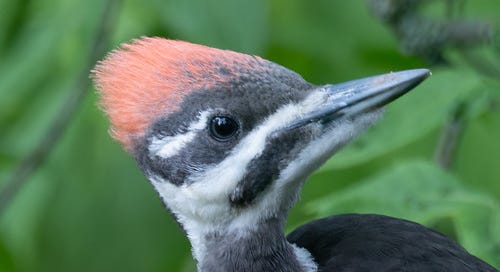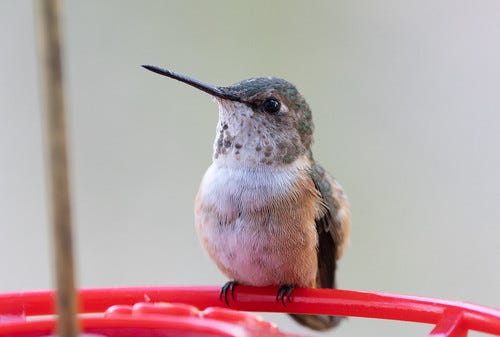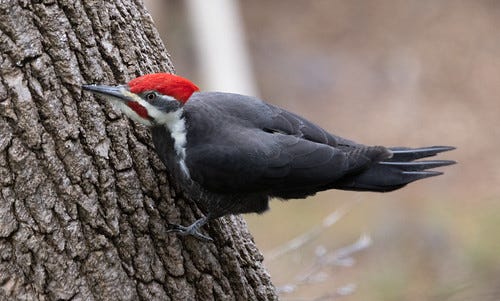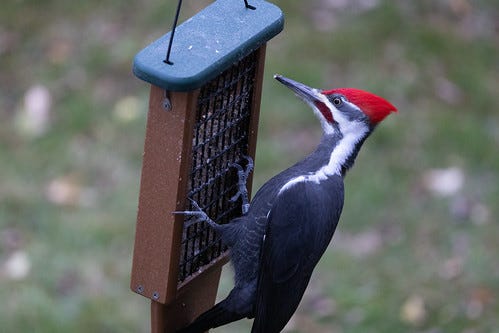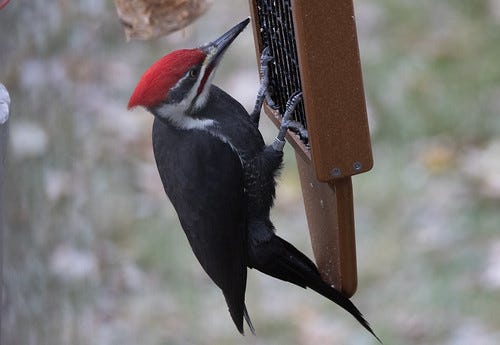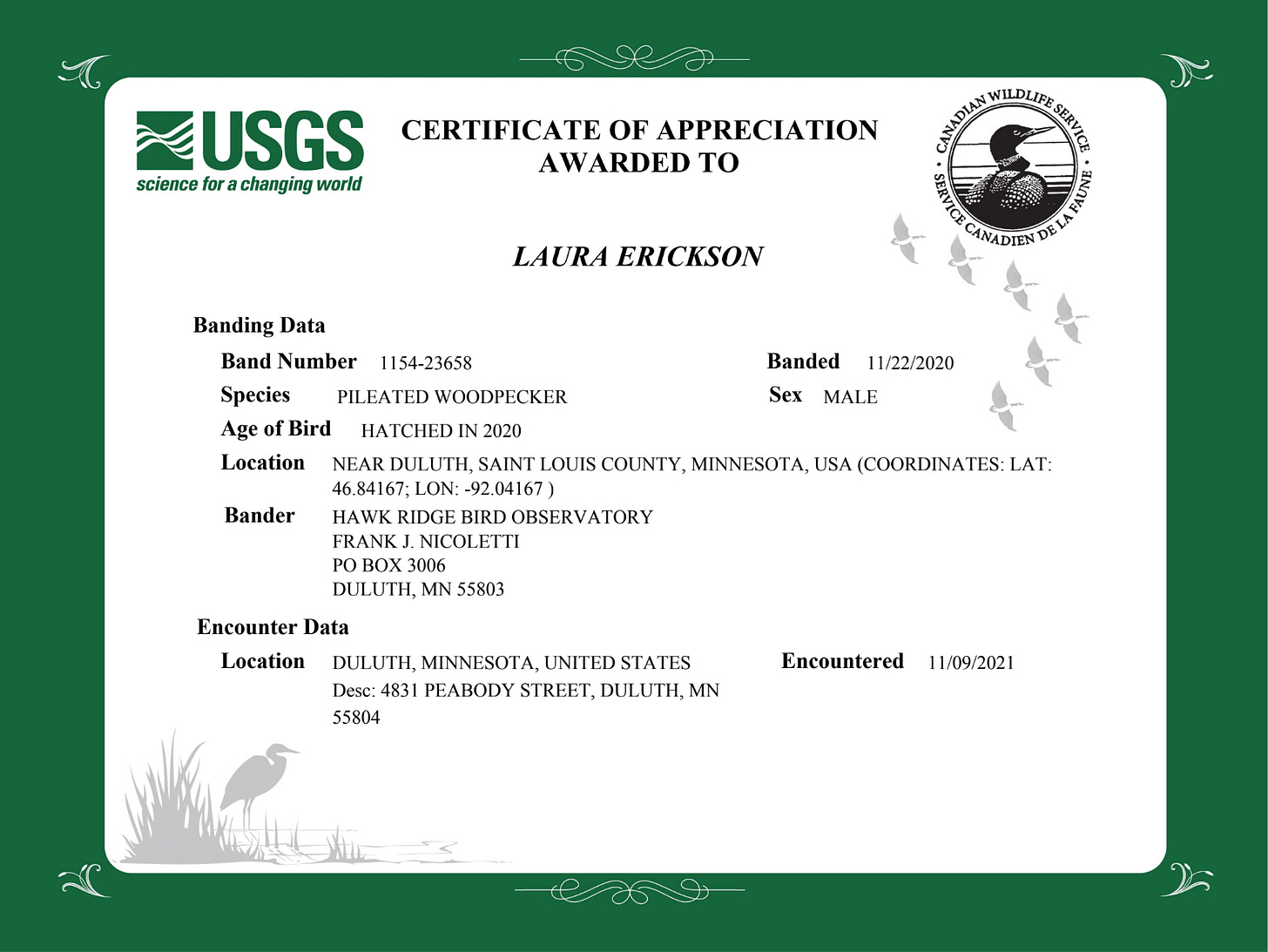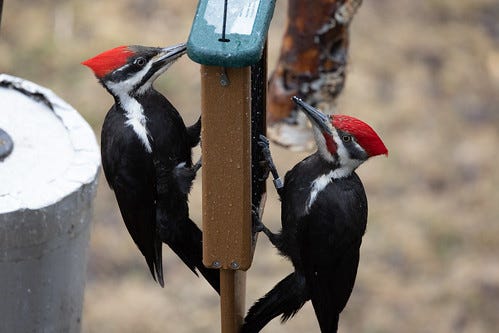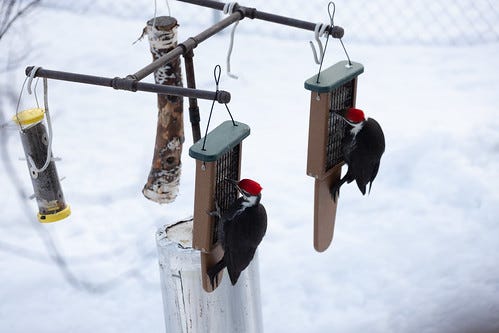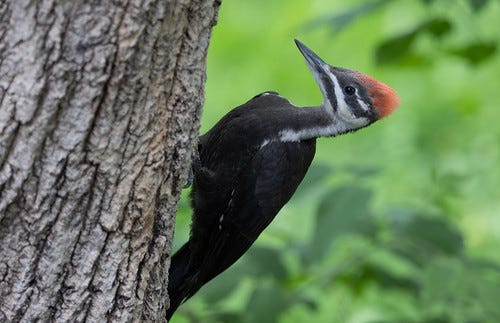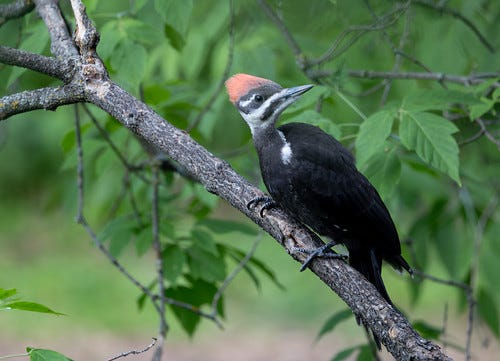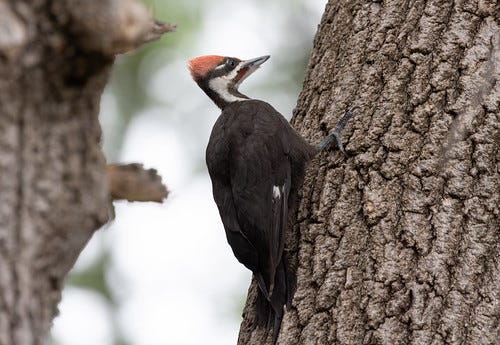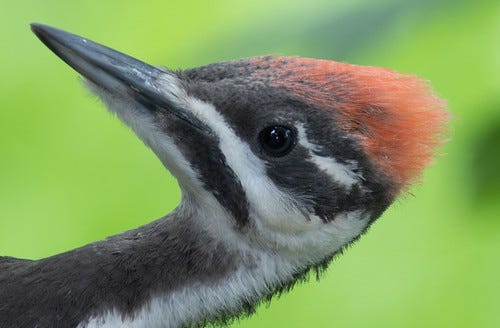(Listen to the July 14 radio version here.)
In November 2021, an adult female Selasphorus hummingbird turned up in my neighborhood, and as soon as I set out my own feeders, she started spending a lot of time in my yard.
It took quite a few days to confirm that she was a Rufous Hummingbird, and even after that, I kept watching for and photographing her. (I wrote a long Q&A blogpost about her and the issue of feeding hummingbirds in winter here.)
Watching my yard so much, I couldn’t help but pay closer attention to other birds, like a male Pileated Woodpecker who seemed exceptionally comfortable in the side yard even when birders were right at the fence or when dog walkers passed by at close range. Most pileateds are much more skittish than that!
One night when I was looking at the day’s photos, I noticed an aluminum numbered band on his right leg, and going back through the photos of previous days, I saw that the band was visible on several photos.
In photos where the band was visible at all, it was often in focus, allowing me to read the numbers facing me. USF&W bands have 9 digits, but at best, only three or four numbers are ever visible in a single photo. Fortunately, the band shifted positions between one visit and another.
Each band has a noticeable seam which was visible in about half my band photos, making it easy to work out the first and last digits. Little by little over the next few weeks, capturing short strings of numbers at a time, I worked out the entire band number (115423658) so that I could report the bird to the Bird Banding Lab. That’s how I found out that this particular Pileated Woodpecker had been banded at Hawk Ridge by Frank Nicoletti on November 22, 2020 as a hatch-year bird, making him two or three months older than my grandson Walter.
Until my hummingbird showed up, I hadn’t been taking many photos of pileateds in my yard that year, being too focused on my new baby grandson. But this woodpecker was so comfortable with the activity in and around my yard that he had almost certainly been coming for weeks or maybe even months before I noticed the band—I’ll never know.
My hummingbird lit out for the territory on December 4, but the Pileated Woodpecker came several times a day through the entire winter. It’s pretty much impossible for me to watch an individual bird day after day like that without developing strong feelings toward it—I started calling this guy BB for Banded Boy.
When spring arrived, BB didn’t visit quite so regularly, and a few times when he showed up, it was with a female. On April 23, 2022, I got a photo of the two of them on the same feeder, but that turned out to be one of the last times I saw him until late summer.
I presume he nested but couldn’t be sure. But that fall and winter he was back at my feeder a few times every day again. And again this spring a female started arriving with him a lot. On March 28, 2023, I got a photo of them feeding side by side in two suet feeders.
Unlike 2022, this year BB never entirely disappeared. I might go a day or two without seeing him, but most days he showed up once or twice. Woodpeckers virtually never leave their eggs or tiny nestlings unattended, the pair taking turns incubating and brooding. I figured they were probably nesting several blocks away.
My yard is clearly in BB’s regular foraging range, and I surmised that he came for easy meals when he was off nest duty. I was afraid he was going to leave me guessing again about whether he’d nested successfully.
I stopped seeing him for several days in early July. Hope is the thing with feathers, so I naturally hoped this was when his babies were fledging—that would keep him close to the nest until the young were all capable of following him about. But again, this was just speculation.
Then on July 10, I was at my desk about 5:20 pm when there he was in the feeder, and up in the box elder was another Pileated—a fledgling! BB was here with his daughter! Her body was full size, as woodpeckers always are when they fledge. I knew she was a fledgling because of her slightly short beak, her slightly duller and sparser red crest, and her gray rather than golden eyes. For solid proof, BB flew up and fed her. I got several photos of her but not while he was feeding her—they were behind too many leaves.
(The only time I’d ever seen an adult and a fledgling Pileated Woodpecker interacting before this was in July 1988, long before I was taking bird photos. I wrote about a male feeding his daughter near Burntside Lake for my July 18, 1988 radio program—transcript and program here.)
After feeding his daughter, BB returned to the feeder as she flew from tree to tree near the feeder. I could see her doing some probing for her own food. Then they flew off toward the back of the yard. I ran out and got one last photo of her, on the telephone pole in the back of the yard.
The next day, the 11th, BB returned with a male fledgling.
And on the 12th I saw BB in the feeder briefly, but something spooked him and he flew off, two fledglings following. This morning, the 13th, I saw him at the feeder very briefly but couldn’t pick out any others.
I haven’t seen the adult female all month, but my yard wasn’t part of her regular feeding route so that doesn’t surprise me. I’ve got proof now that this pair raised at least two chicks, and since Pileated parents seem to split up the brood to cover more ground while foraging, I would bet that at least one or two were with her while BB foraged with the others.
The oldest Pileated Woodpecker on record, an adult male, was banded in Maryland in 1979 and retrapped and released in 1991 when he was a minimum age of 12 years 11 months. I’ll keep watching for BB as long as he sticks around my neighborhood, hoping against hope that eventually he’ll break the record, though the only way I’ll be able to document it is if I make it into my 80s, breaking the longevity records of my own family. Meanwhile, seeing this beloved bird raising healthy fledglings fills me with joy, calling to mind my new favorite word, coined by National Geographic’s Extraordinary Birder, Christian Cooper. This is FANTABULOUS!


